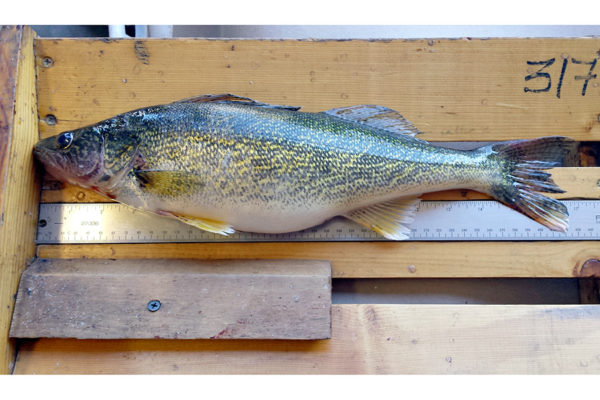Fish detectives in Northwest Montana have used a biochemical sleuthing technique to determine the origin of a pair of walleye illegally introduced in Swan Lake, leading them closer to identifying the culprits.
The information gleaned by Montana Fish, Wildlife and Parks investigators is akin to biological fingerprinting, and the biochemistry employed could help them unravel the case.
The key piece of evidence? Tiny bones collected from the inner ears of the walleye, which hold a wealth of information.
Like a tree’s concentric growth rings, a small bone within a fish’s ear reveals a history of its growth. The bone also contains a record of its migration pathways — a kind of geochemical diary of its life.
The bone, called an otolith, acquires a new ring every day of the fish’s life. All fish have them, and for decades scientists have counted the bands of the bone to determine the age of a fish, as well as to estimate population growth.
Otoliths also contain a unique fingerprint of the water chemistry where the fish swims on a given day, which can be used to map the entire life history of a fish within a lake or river network.
The analysis of the walleye caught in October 2015 revealed that Swan Lake was not their natal water, providing conclusive evidence that they were transported from somewhere else.
But where?
FWP fisheries biologist Sam Bourret, the lead researcher on the project, studied the intricacies of the walleyes’ otoliths and compared them to other walleye from 14 popular fisheries across the state, all of them known to contain walleye populations.
The research paid off, turning up a positive match with Lake Helena, about 10 miles from Helena.
The information provides an important clue into the ongoing investigation of who illegally introduced the walleye.
Bourret said employing the evolving technology to help track illegal introductions, and potentially identify the perpetrators, is a step in the right direction.
“Illegal fish introductions are a huge problem both ecologically and socially, and fish managers have few tools to combat the pervasive issue,” Bourret said. “This research gives managers a tool in their arsenal to help convict perpetrators.”

A mere two walleye might not sound like a threat, but the fish breed prolifically and feed voraciously. If a population takes hold in Swan Lake, the threat to native bull trout, a threatened species, would be significant.
The danger posed in Swan Lake is particularly troublesome as the pristine water body has been identified as a refuge for cold-water species like bull trout, which, if climate-model predictions prove correct, could face the loss of habitat over time.
The state department’s concern is shared by the fishing community and conservation organizations, which stepped up to bolster the investigation by offering a monetary incentive.
Following discovery of the fish, the fishing and conservation organizations contributed a reward of $35,250 in exchange for information leading to the conviction of whoever is responsible for the illegal introduction. The state of Montana is offering a reward of up to $15,250 for information about illegal fish introductions. Montana Trout Unlimited has pledged a reward of $20,000 for a tip that results in the conviction of the individual or individuals responsible for illegally introducing the walleye into Swan Lake.
The Swan Lake discovery is just the latest in a string of outlaw fish plantings commonly known as “bucket biology” — the illegal act of moving live fish from one body of water to another. It’s a practice adopted by rogue anglers looking to establish new fishing opportunities, and it has damaged fisheries across Montana, particularly in this corner of the state.
The problem is not only with walleye. Other warm-water species, including crappie, perch and lake trout, also have been illegally introduced into Montana lakes.
Anyone with possible information about who introduced walleye into Swan Lake is encouraged to call 1-800-TIP MONT. Callers do not need to identify themselves and may be eligible for the cash reward.
Mark Deleray, FWP’s regional fisheries manager in Kalispell, said it’s unclear how many people are involved in illegal introductions across the state, but gathering information on the cases helps officials tackle the problem.
“We need help from local citizens to catch those responsible for the illegal introduction,” Deleray said. “We expect the large reward will result in information.”
The Fish and Wildlife Commission approved a mandatory kill regulation for walleye in Swan Lake, Swan River and their tributaries. All walleye caught by anglers must be kept and immediately killed. Walleye must be reported to FWP within 24 hours, and arrangements made for the entire fish to be turned into FWP within 10 days.
Leo Rosenthal, FWP’s fisheries biologist on Swan Lake, said it’s discouraging when illegal introductions are discovered. However, he said the fact that the captured walleye hailed from another lake and are not part of an established breeding population is heartening.
“It’s encouraging that we’re not catching lots of small walleye out there,” he said. “That gives me some hope that there’s not a reproducing walleye population out there. There is concern that there are more of them out there, but the fact that we haven’t caught any more as by-catch from all of the different types of monitoring work and netting we do out on the lake gives me some hope.”
